This homemade Korean kimchi is loaded with umami flavor and is surprisingly simple to make. Pieces of napa cabbage are coated in a flavor--packed paste and then left to ferment for 1 to 5 days.
After the fermentation, it is ready to eat as is or add to a variety of recipes. Check out how to make kimchi below as well as some helpful tips and information.
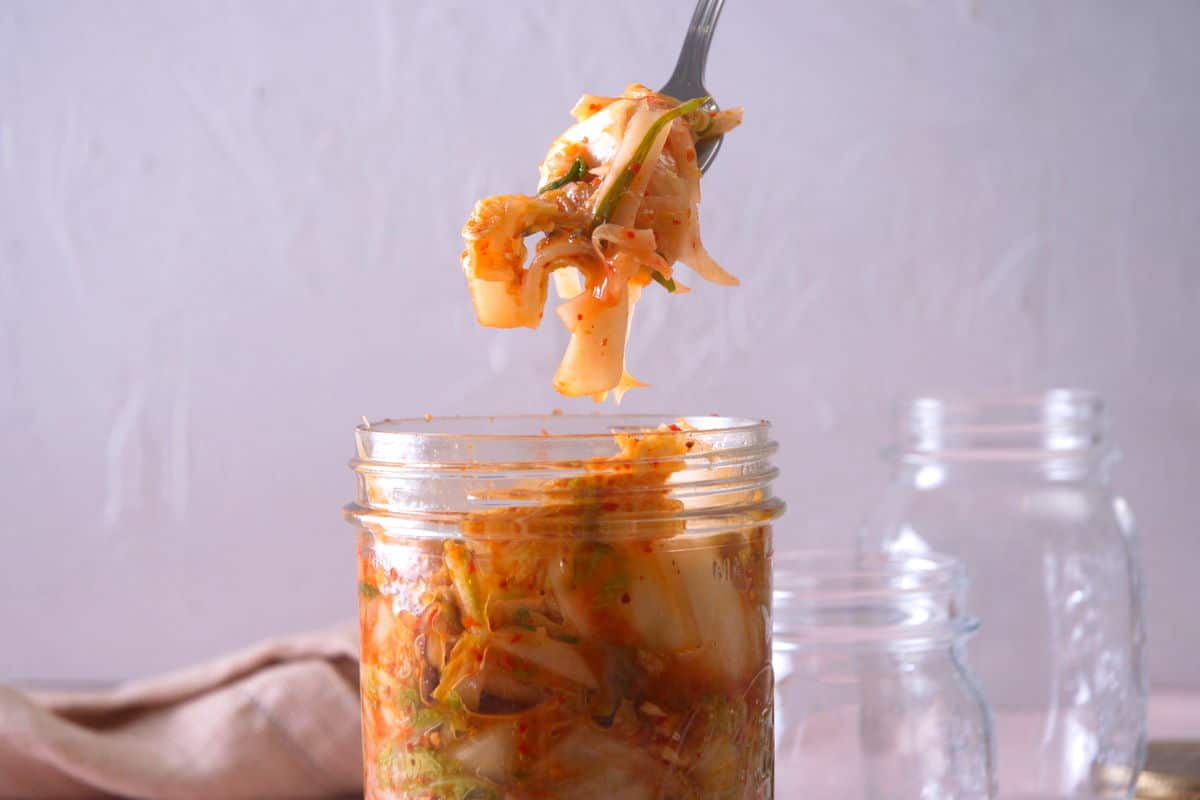
Jump to:
- What is Kimchi?
- Kimchi History
- Kimchi Ingredients
- Equipment
- Step 1: Core the Cabbage
- Step 2: Salt the Cabbage
- Step 3: Massage the Salt into the Cabbage
- Step 4: Add Distilled Water
- Step 5: Let the Cabbage Sit
- Step 6: Drain the Salt Water
- Step 7: Make the Paste
- Step 8: Combine the Vegetables
- Step 9: Add Paste
- Step 10: Transfer the Kimchi to Jars
- Step 11: Ferment the Kimchi
- Step 12: Serve!
- How to Store Kimchi
- Kimchi FAQ
- Kimchi Uses
- Where to Buy Kimchi
- 📋Recipe
What is Kimchi?
Kimchi is a Korean side dish made of fermented, seasoned vegetables; mainly napa cabbage and daikon radish. It’s basically a more complex, Asian version of sauerkraut.
There are many different types of kimchi such as kkakdugi, mul and chonggak, to name a few. We are sticking to the classic kimchi with napa cabbage in this recipe.
It is a very versatile food, which is why you will see me using it in all sorts of fusion creations.
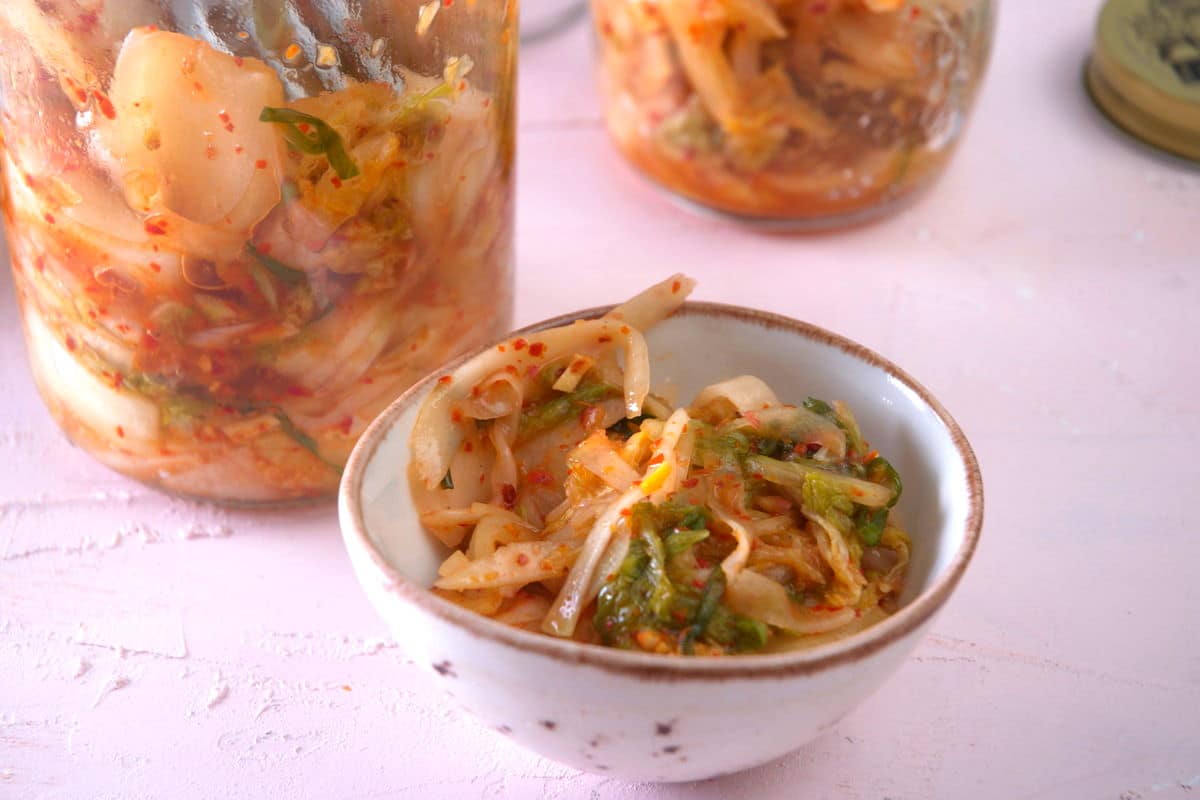
Kimchi History
Kimchi had its beginnings in Korea during the Goryeo dynasty (between 918 and 1392), when food preservation was an important skill to have due to the cold winters. They would preserve foods by salting them in order to take advantage of the nutrients found in vegetables when they weren’t in season.
Although kimchi was first made with radishes, cabbage took over as the main ingredient as it found its way to the area through trade.
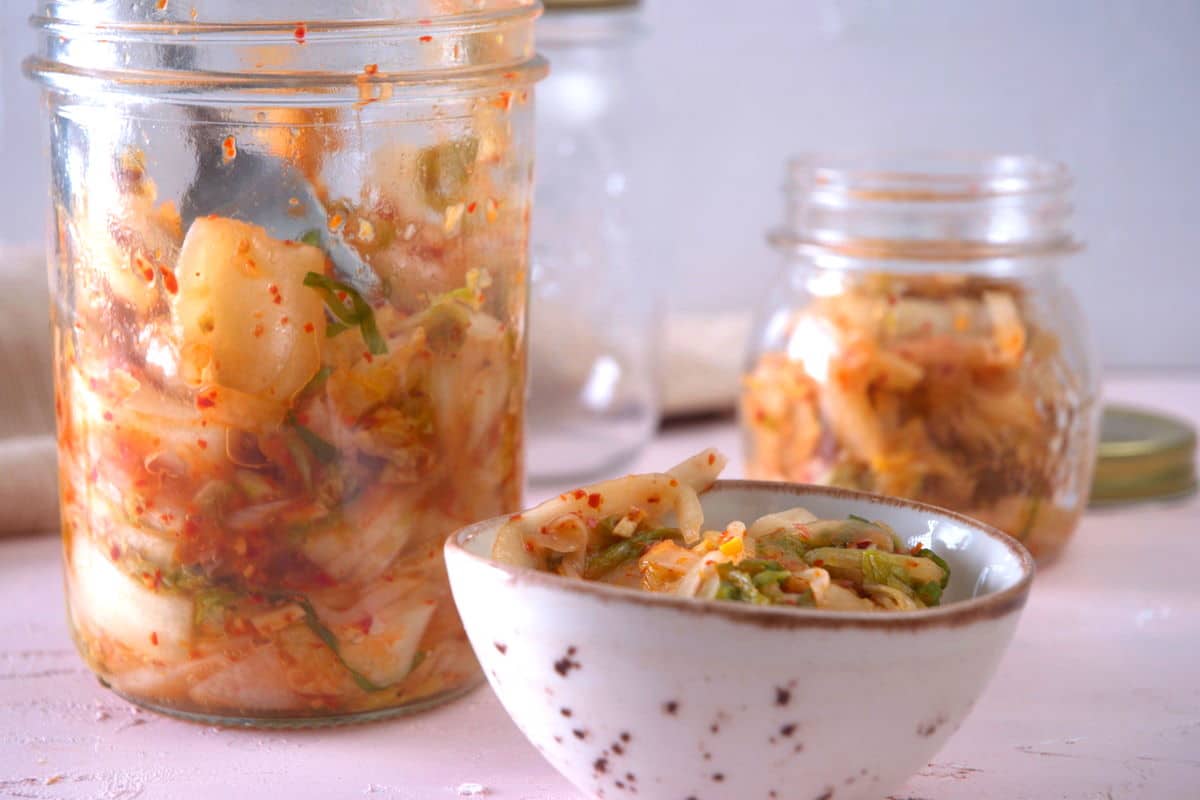
Kimchi Ingredients
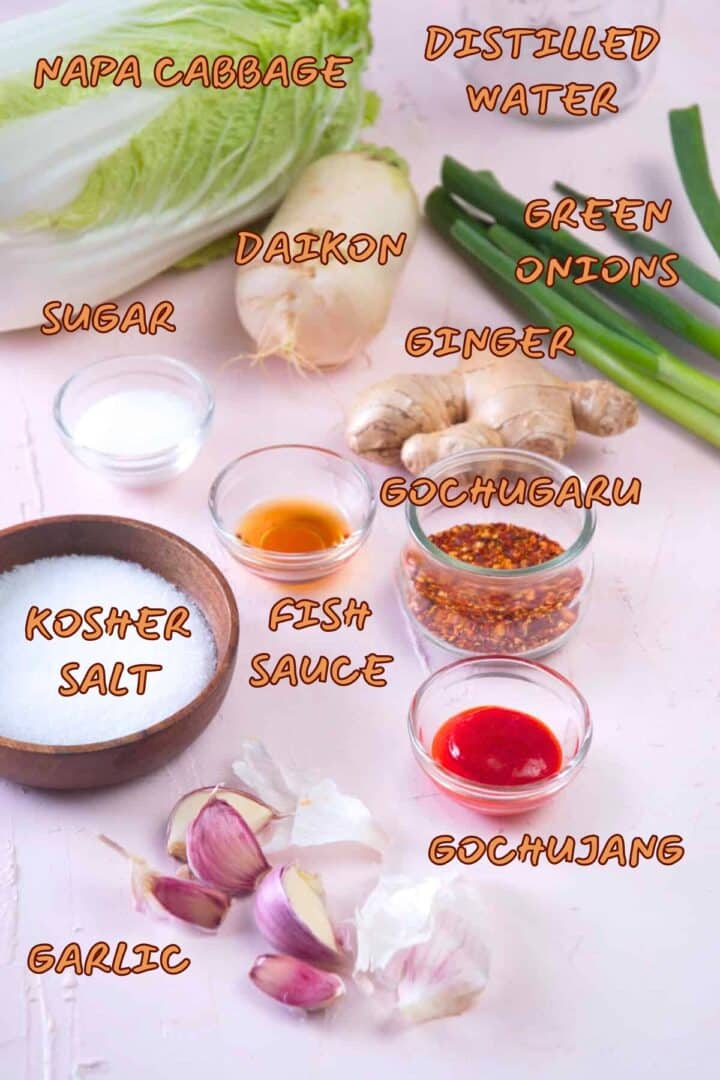
- 2 pounds napa cabbage (1 large head)
- ¼ cup kosher salt
- distilled water - enough to cover the cabbage
- 5 cloves garlic - minced
- 1 tablespoon fresh ginger - minced
- 1 teaspoon sugar
- 2 tablespoons fish sauce
- 3 tablespoons gochugaru (Korean red pepper powder/course ground)
- 2 tablespoons gochujang paste
- 1 cup daikon radish - peeled and grated
- 3 green onions - sliced
If you don't like it spicy, add less gochujang or gochugaru.
Equipment
As for equipment, you will need wide-mouth mason jars, a large bowl and a colander.
Step 1: Core the Cabbage

Remove any damaged outer leaves from the napa cabbage and then slice it into quarters. Core the cabbage and cut it into 2” pieces.
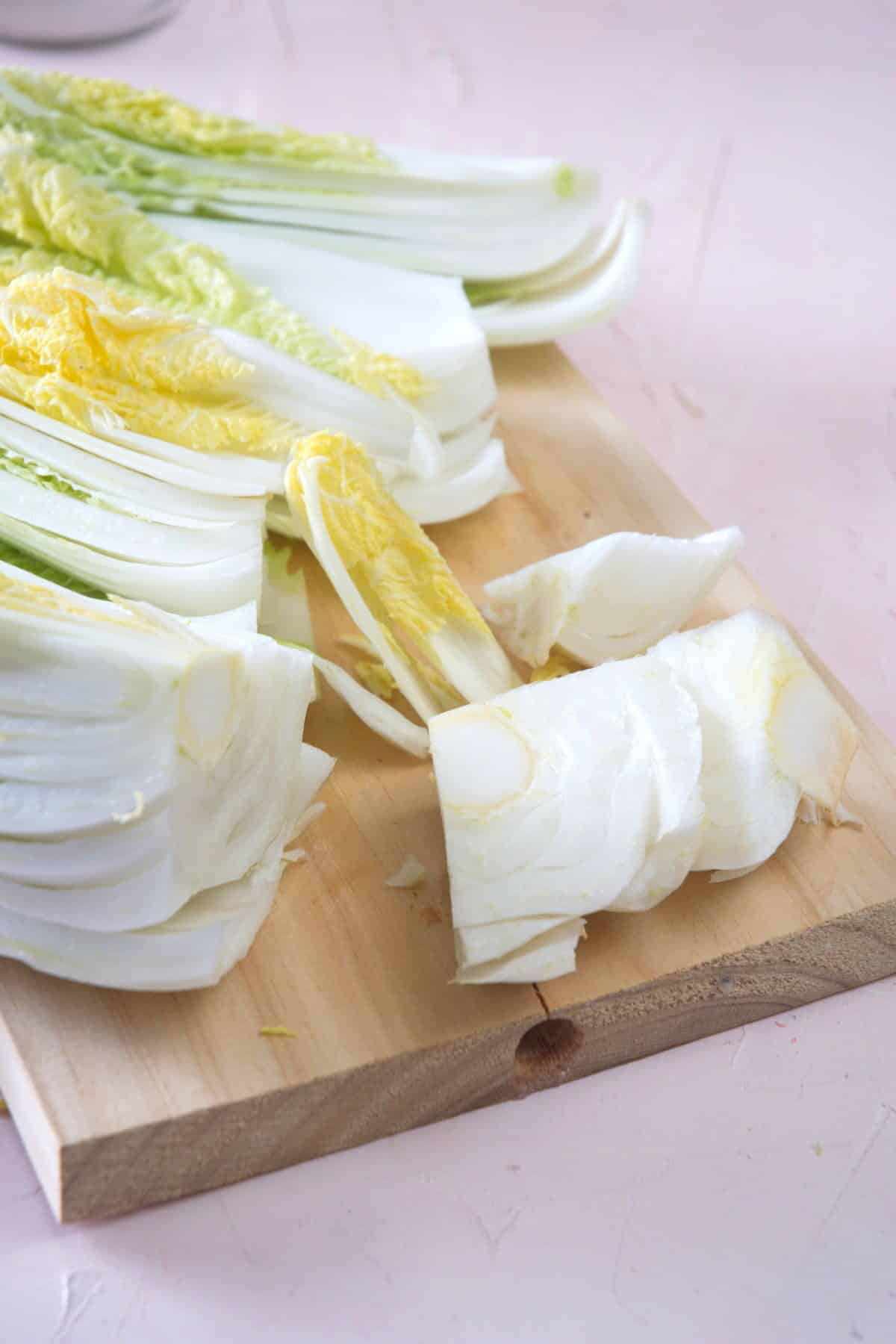
Step 2: Salt the Cabbage
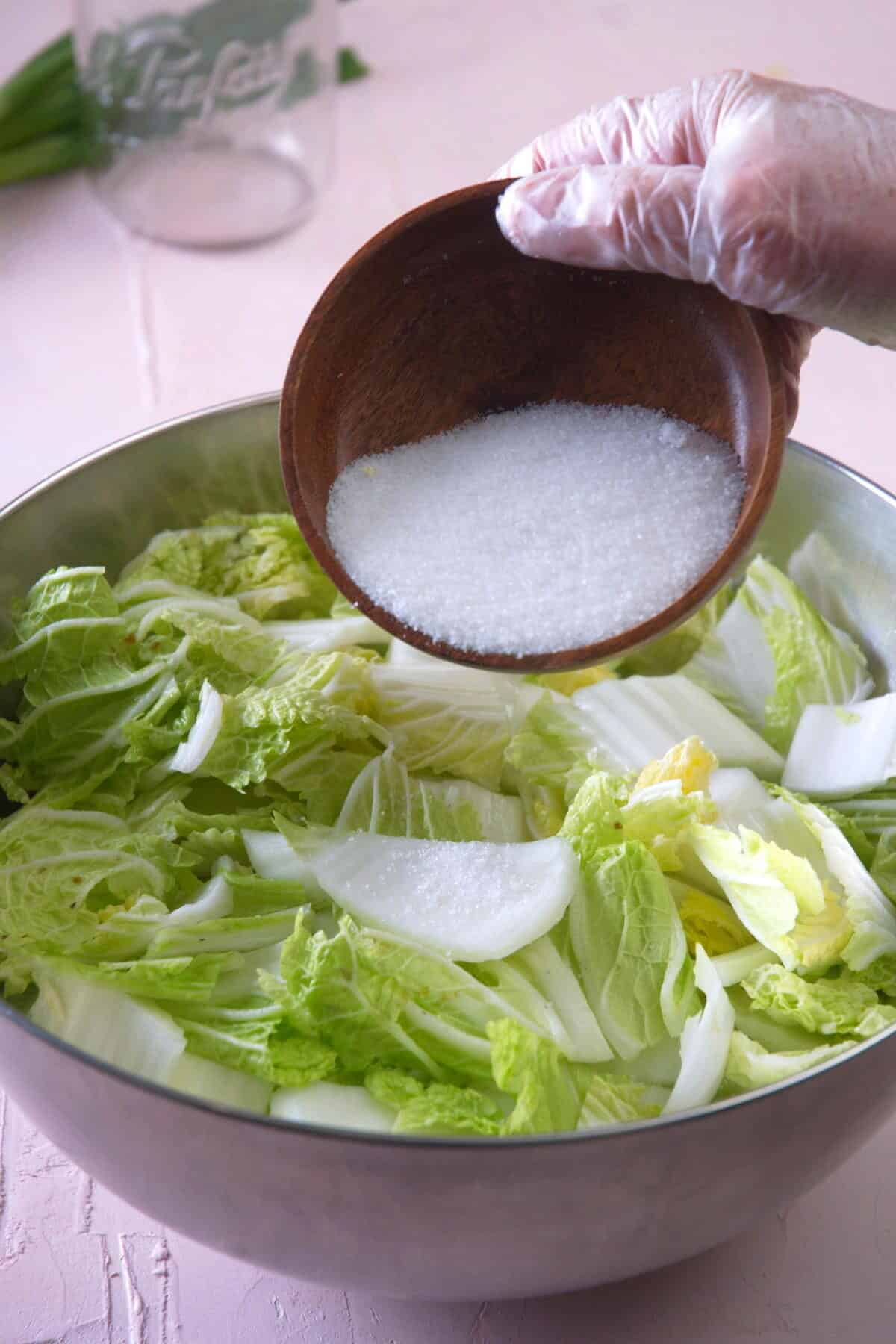
In a large bowl, add the cabbage pieces and salt.
Note: Make sure you use kosher or sea salt so that it is free of additives/iodine, which is believed to negatively affect the fermentation process.

Step 3: Massage the Salt into the Cabbage
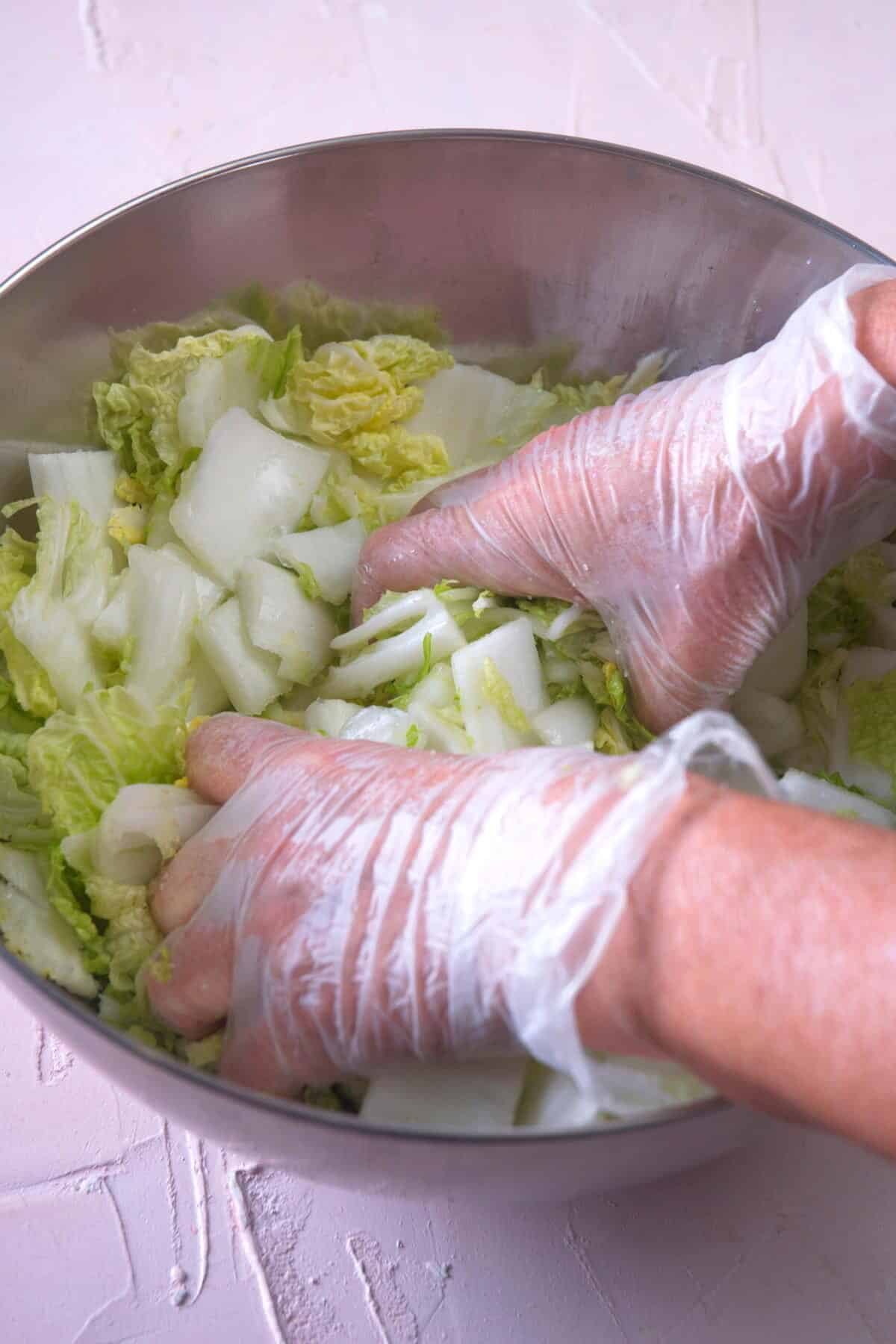
Massage the salt into the cabbage with your hands.
Step 4: Add Distilled Water
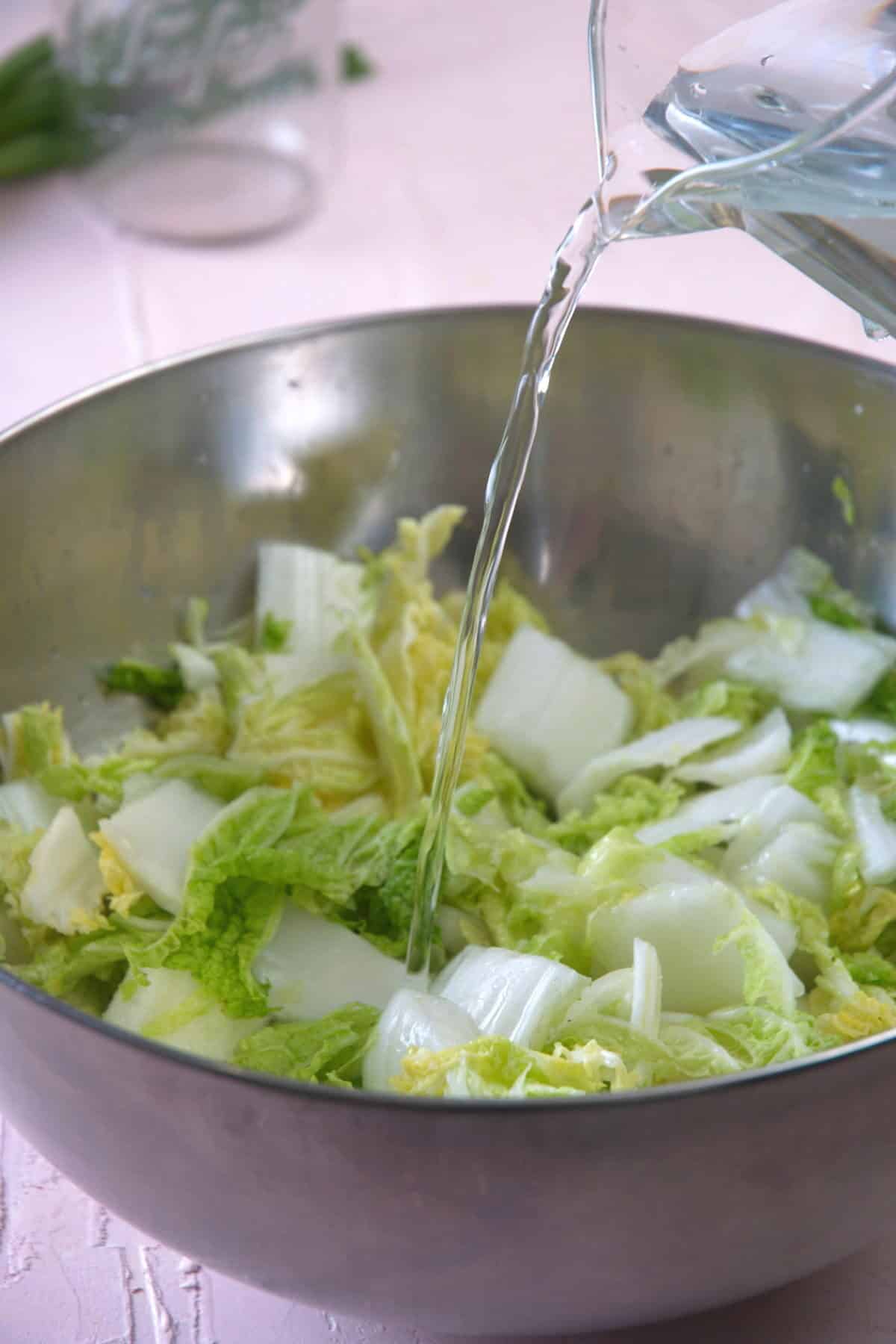
Add enough of the distilled water to cover the cabbage. Stir until the salt has been dissolved.
Step 5: Let the Cabbage Sit
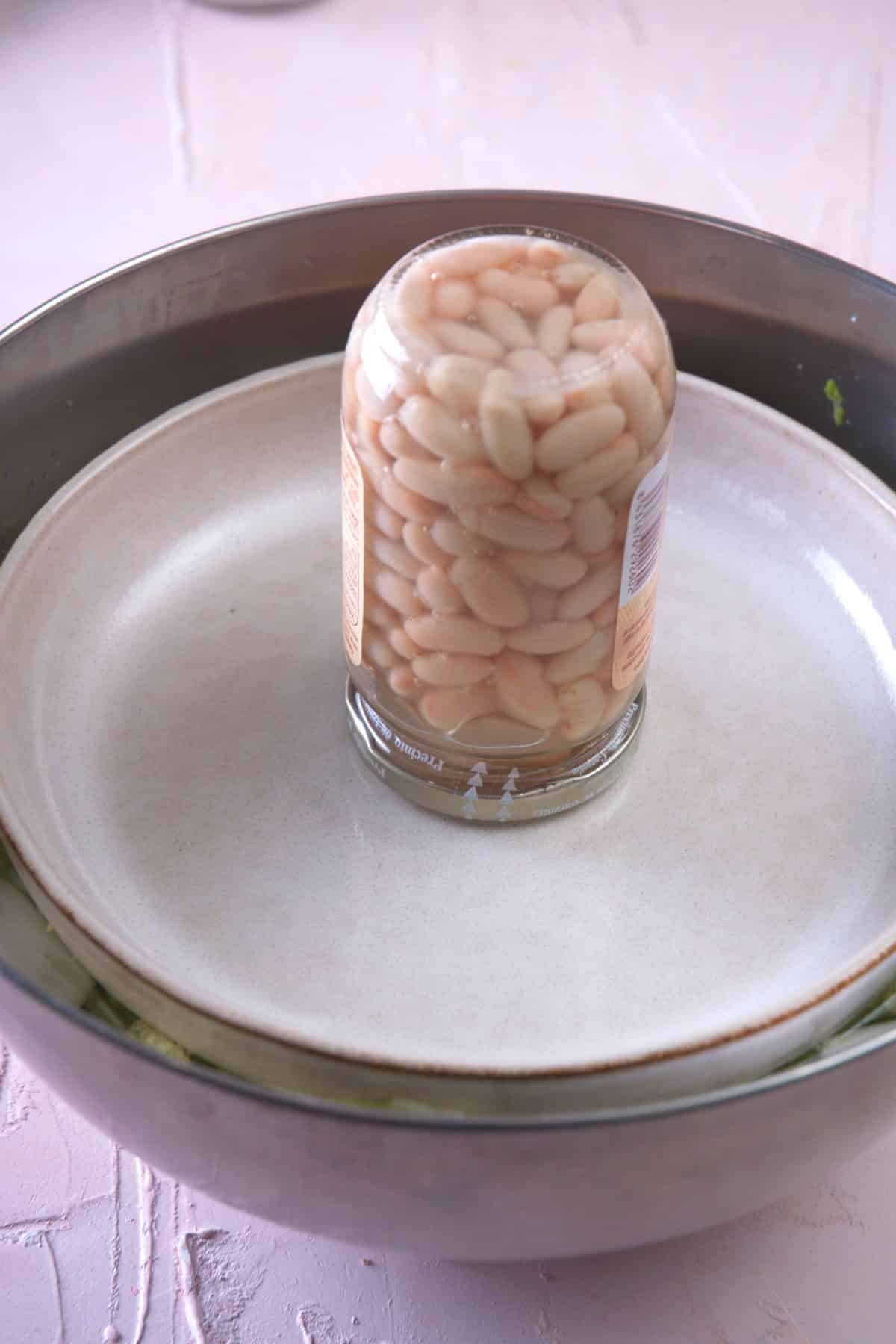
Cover the cabbage with an inverted plate and weigh it down with something heavy, like a jar/can. Let it sit for at least 2 hours at room temperature or up to 5 hours. This will draw out the moisture which will help preserve it and absorb the seasonings later.
Pro Tip: If you like a crispier kimchi, I suggest letting it sit the full 5 hours.
Step 6: Drain the Salt Water
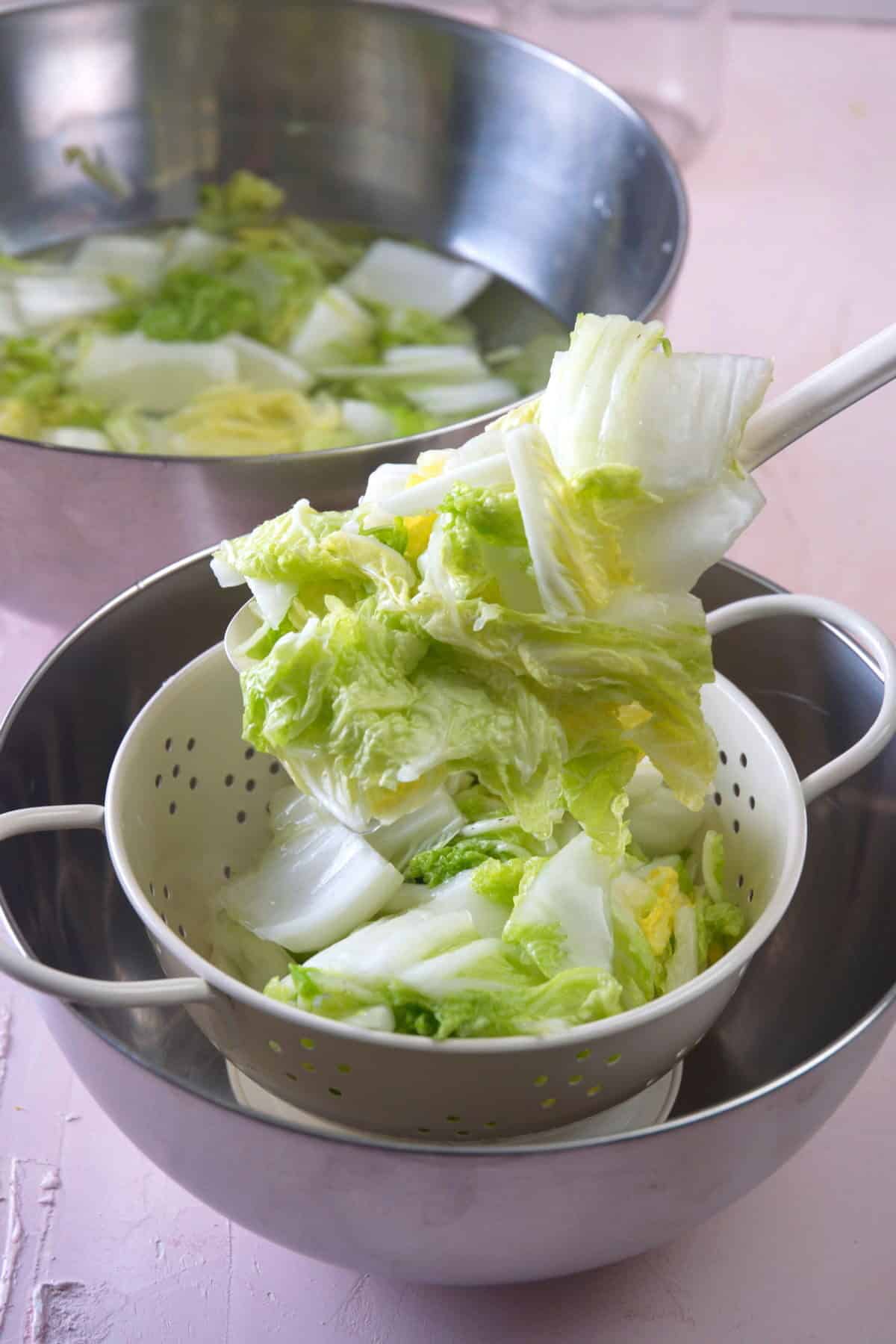
Drain the salt water from the cabbage and rinse it under cold water. Blot with paper towel to dry it and return it to the large bowl.
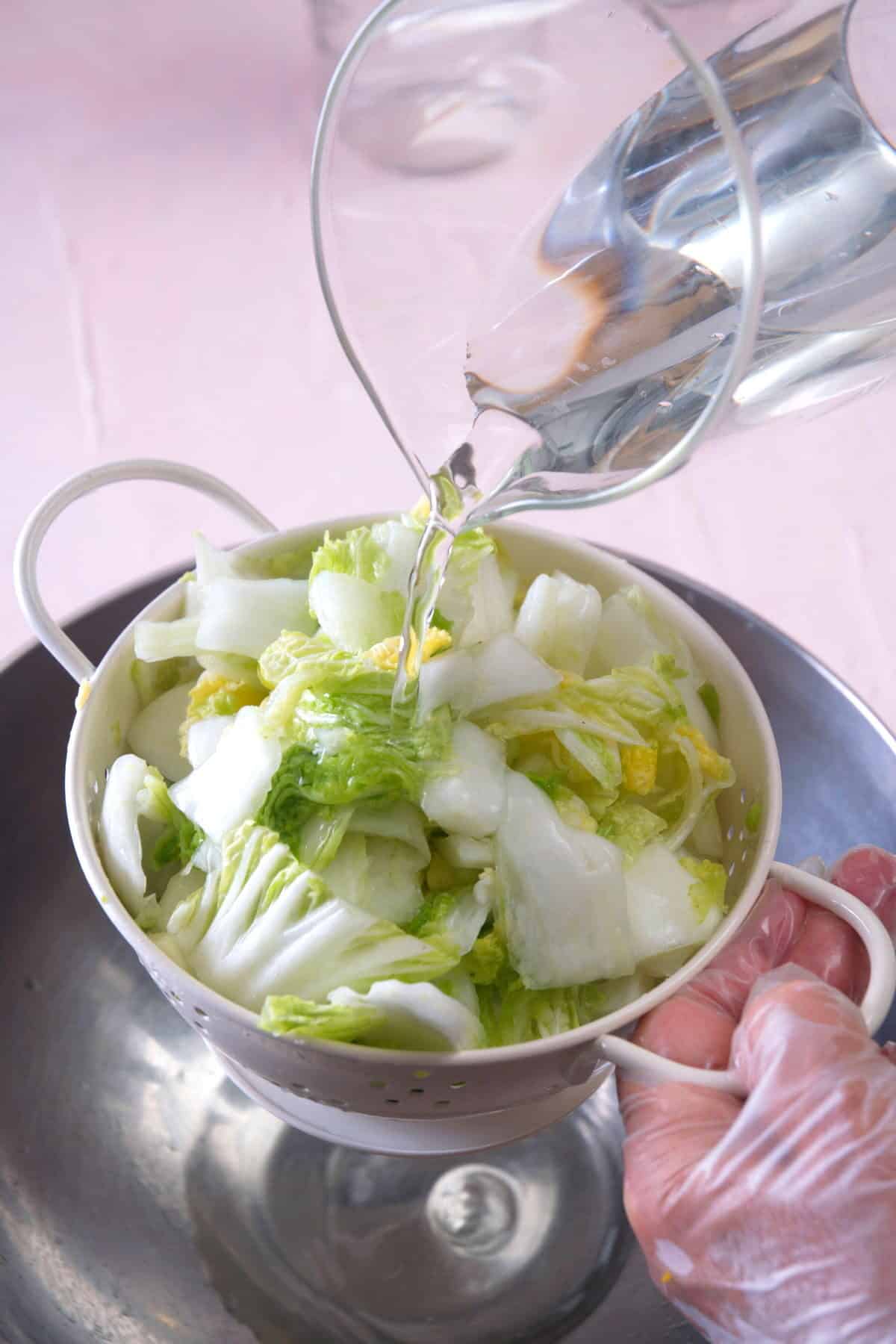
Step 7: Make the Paste
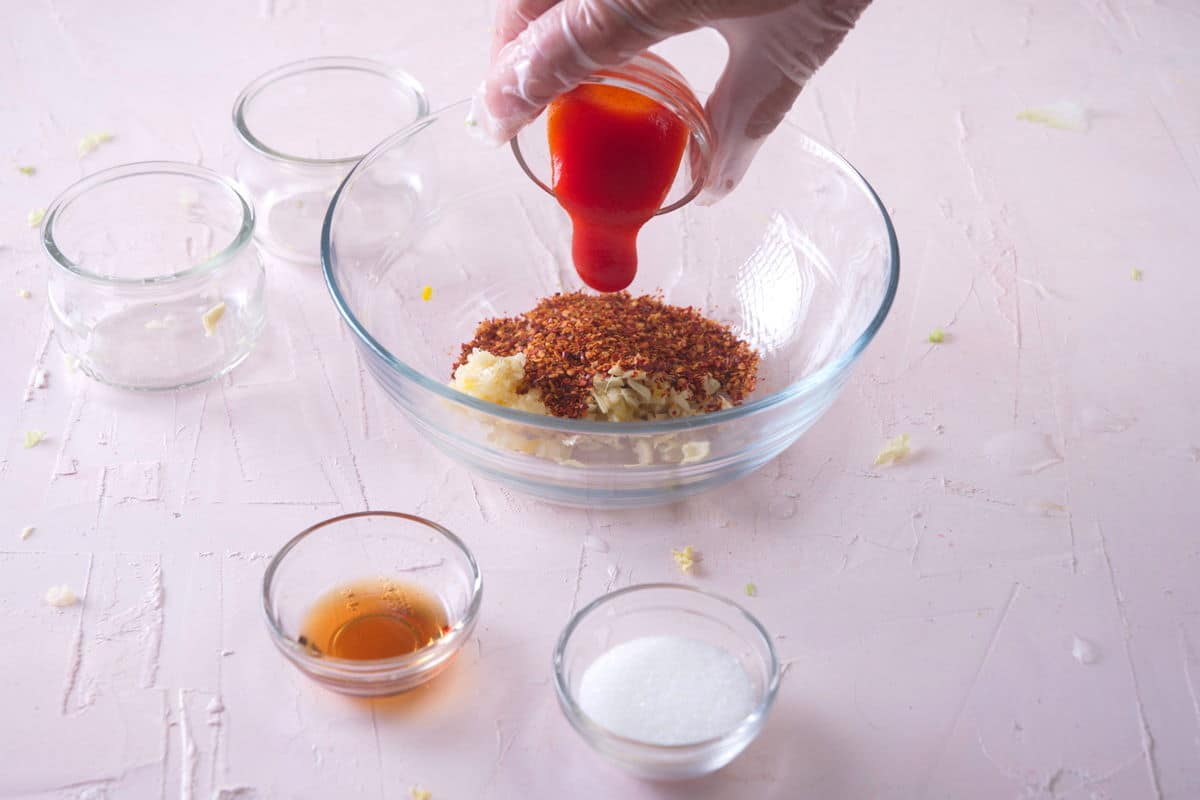
To make the paste, stir the garlic, ginger, sugar, fish sauce, gochugaru and gochujang paste together until smooth.

Step 8: Combine the Vegetables
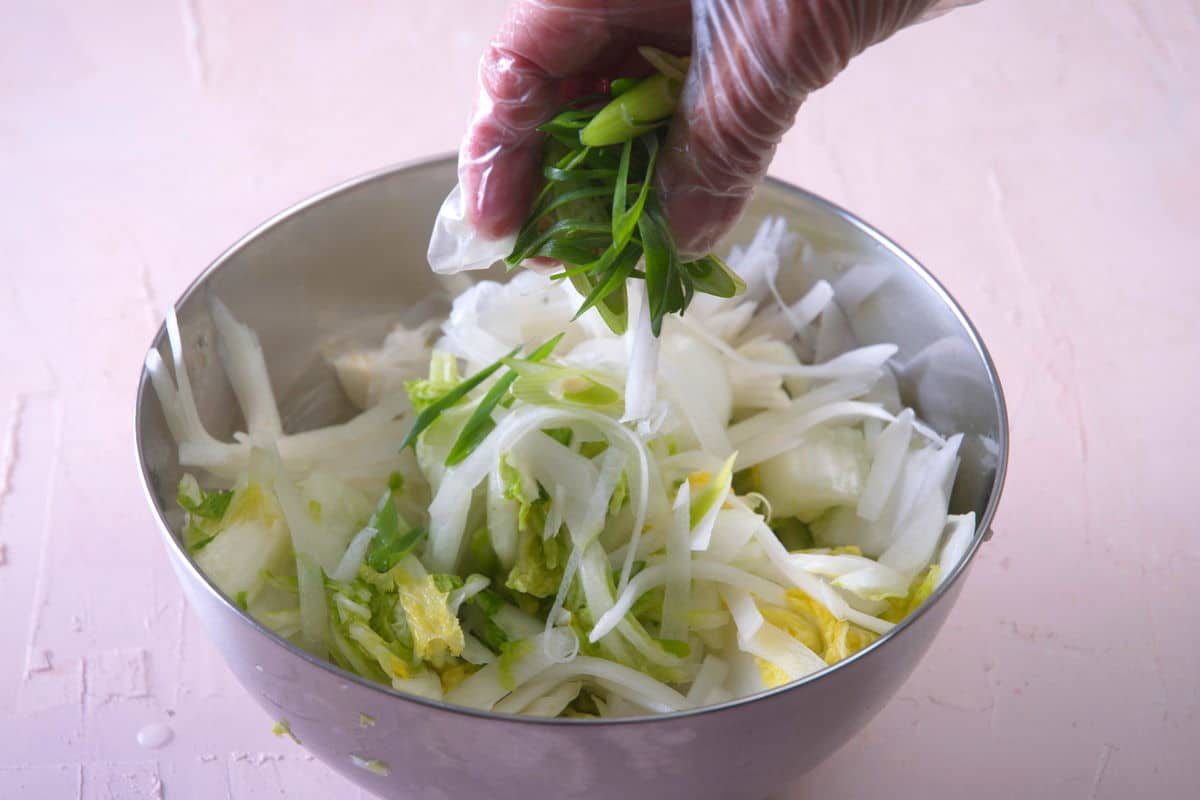
Combine the cabbage with the radish and green onions.
Step 9: Add Paste
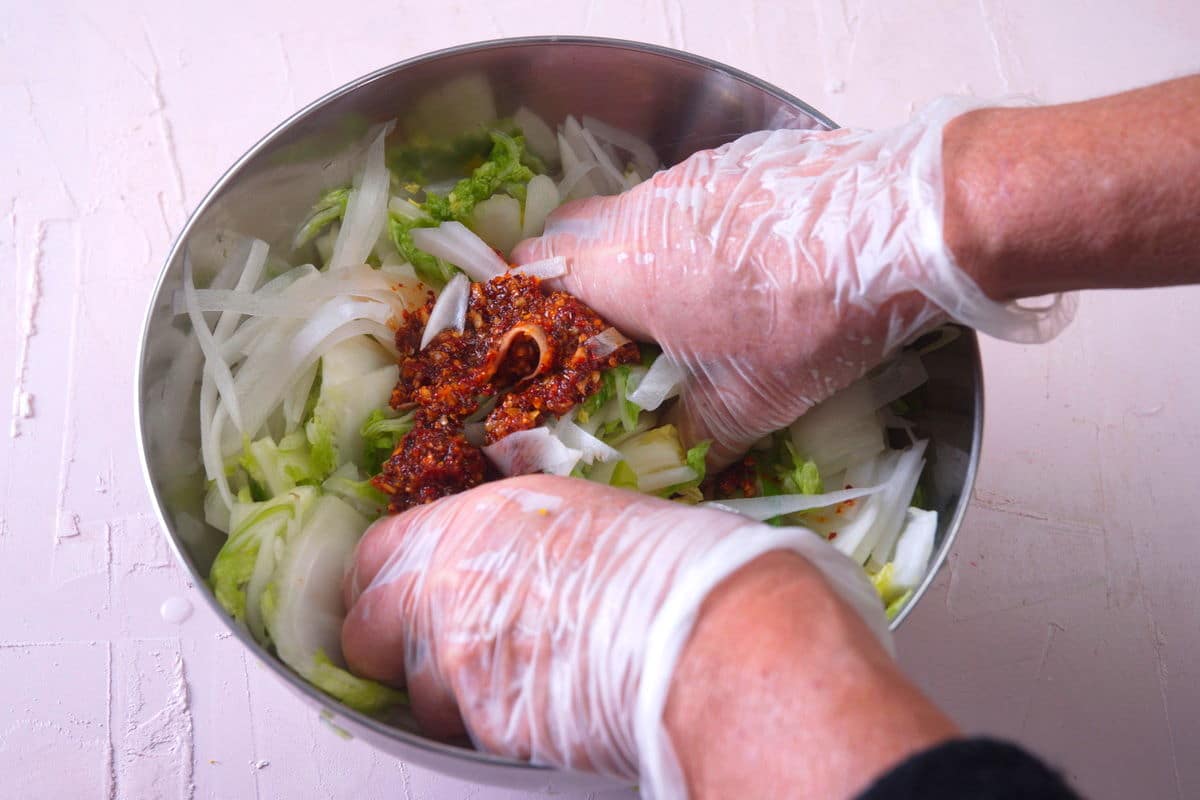
Add the paste. Using your hands (you can use gloves as some of the ingredients are spicy), gently massage the paste into the cabbage mixture until all of the pieces are completely coated.
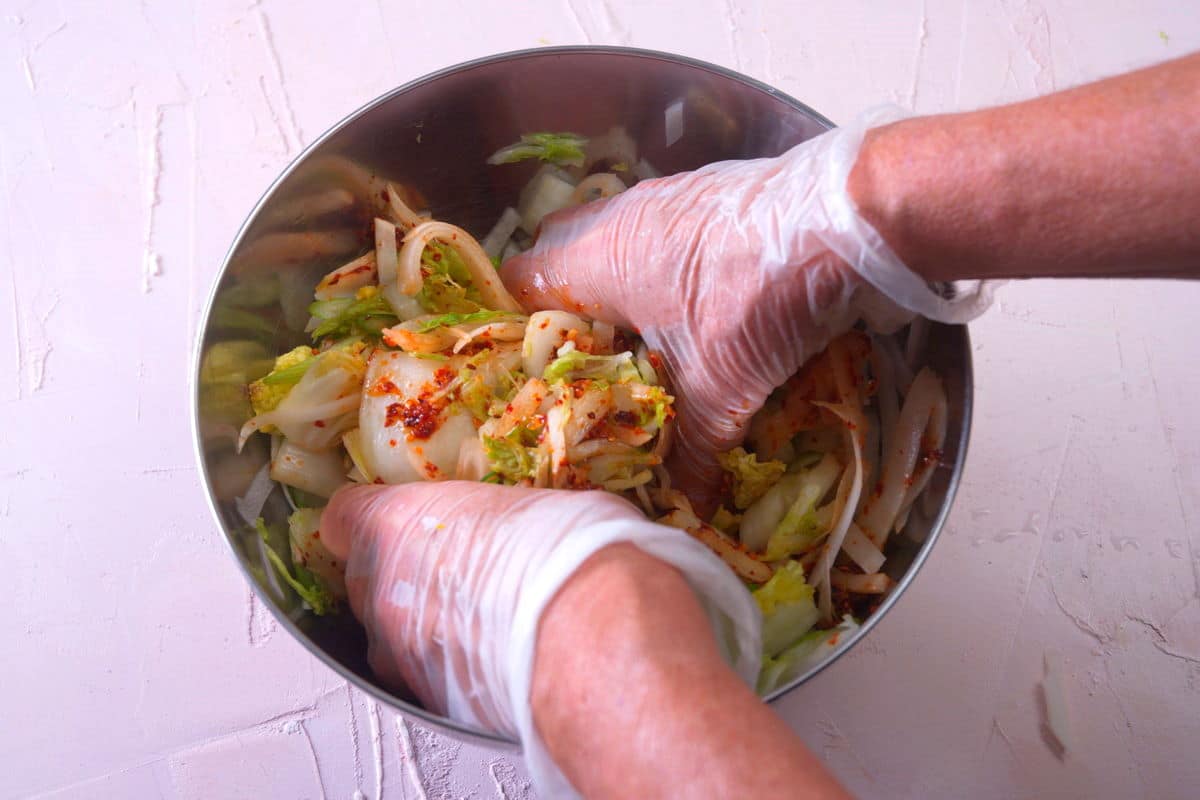
Step 10: Transfer the Kimchi to Jars

Pack the kimchi into sanitized jars, pressing it down as you add it to minimize exposure to air. You want to leave about 2 inches of space at the top of the jar. To help keep the kimchi packed into the liquid, you can use some sort of weight placed on top of it. Wipe the jars down if needed and seal them with the lids.
Pro Tip: It’s important that the cabbage stays covered in the brine for the lactic acid bacteria to multiply and to prevent mold. Fermentation weights come in handy for this or you can also use a cabbage leaf placed on top/tucked in with a weight on top of it. Make sure the weights are the right size for wide mouth jars.
Step 11: Ferment the Kimchi
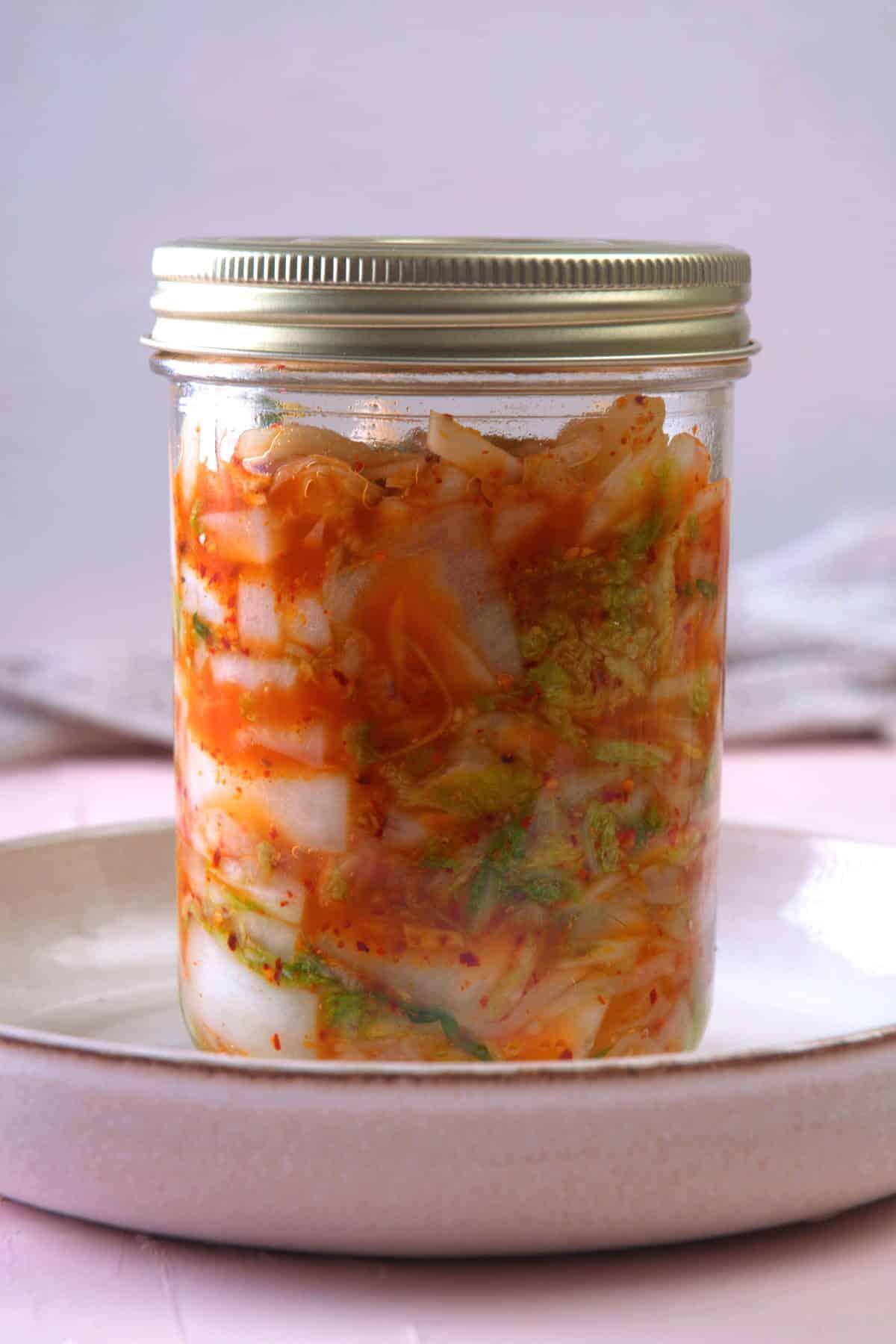
Place the jars in a baking dish (to help catch any juices that may overflow from the release of carbon dioxide) and set them in an area that is cool and dark. Let the kimchi sit for at least 24 hours or up to 5 days. If you see some bubbling and fizzing, that means it is fermenting!
Check the kimchi once per day to press down on the vegetables with a clean spoon and make sure they stay submerged under the brine. The cabbage will slowly release more brine over time. After 24 hours, you can start tasting the kimchi to see if it's fermented to your liking (it will be tangy). If not, you can leave it to ferment longer.
Notes:
- If you need more brine to keep the kimchi covered, you can mix 1 cup of water with 1 ¼ teaspoon kosher salt or sea salt. Use some of this mixture to top it up, if needed.
- The temperature range I ferment my kimchi in is between 65°F/18°C to 70°F/21°C and that seems to work out great. The cooler you keep it, the longer it takes to ferment.
Step 12: Serve!
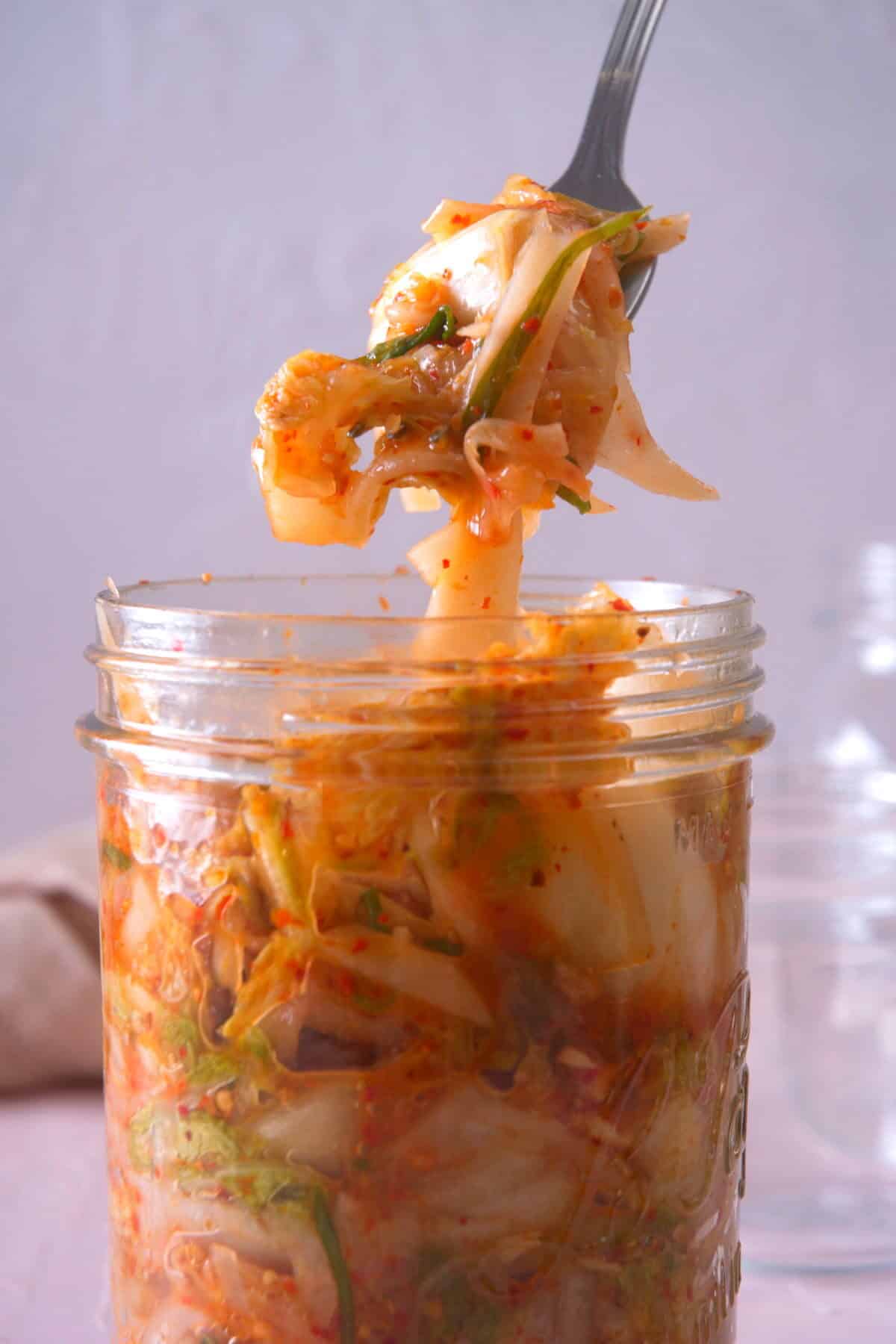
The kimchi is now ready to eat (you can remove the weights and label the jar with the date). For full flavor, slowly ferment it further in the fridge for 1 to 2 weeks. You can eat it as is or add it to many different recipes!
How to Store Kimchi

After the fermentation process, kimchi needs to be stored in the refrigerator, in a covered container, for food safety purposes or it will go bad. This also slows down further fermentation.
It is recommended to open the jar of kimchi slowly over the sink as pressure can build up in the jar from the fermentation process as gases release. You may hear a popping sound; this is normal.
Kimchi FAQ
It can take as little as 1 to 5 days for fermentation at room temperature. You can eat it at this point but it will also continue to slowly ferment as it sits in the fridge.
Kimchi has a very strong, spicy, umami flavor. Because the cabbage is fermented, it will taste sour and tangy.
Fresh kimchi will expire if left at room temperature within a week. Storing it in the refrigerator will extend that time to 3 to 6 months. Keep in mind that as the kimchi gets older, the taste may change and become more sour and the texture may become softer. Always check for mold growth.
It depends. Kimchi can contain seafood ingredients like dried shrimp, anchovies and fish sauce. If you’re making it yourself, just leave out these ingredients. You can easily find vegan brands of kimchi, such as Madge’s or Mother in Law’s. They use ingredients like sea vegetables to get a similar flavor as the non-vegan type.
One of my favorite vegetarian kimchi brands is Rooster. I find it has the best flavor out of the ones I’ve tried so far. It’s imported from South Korea so you know it is authentic. What I don’t like about it, is that it contains msg.
Kimchi is generally a low-carb, keto dish but always be sure to check the nutrition information if using store-bought. If making your own, leave out the sugary ingredients.
Yes, kimchi is gluten free.
Kimchi Uses
Try out some of our best kimchi recipes where kimchi is the star ingredient:
Where to Buy Kimchi
You can find kimchi in Asian food markets, local farmers’ markets or in the refrigerated section of the grocery store. It is also readily available online. Luckily, you won’t need to worry about that if you make it at home!
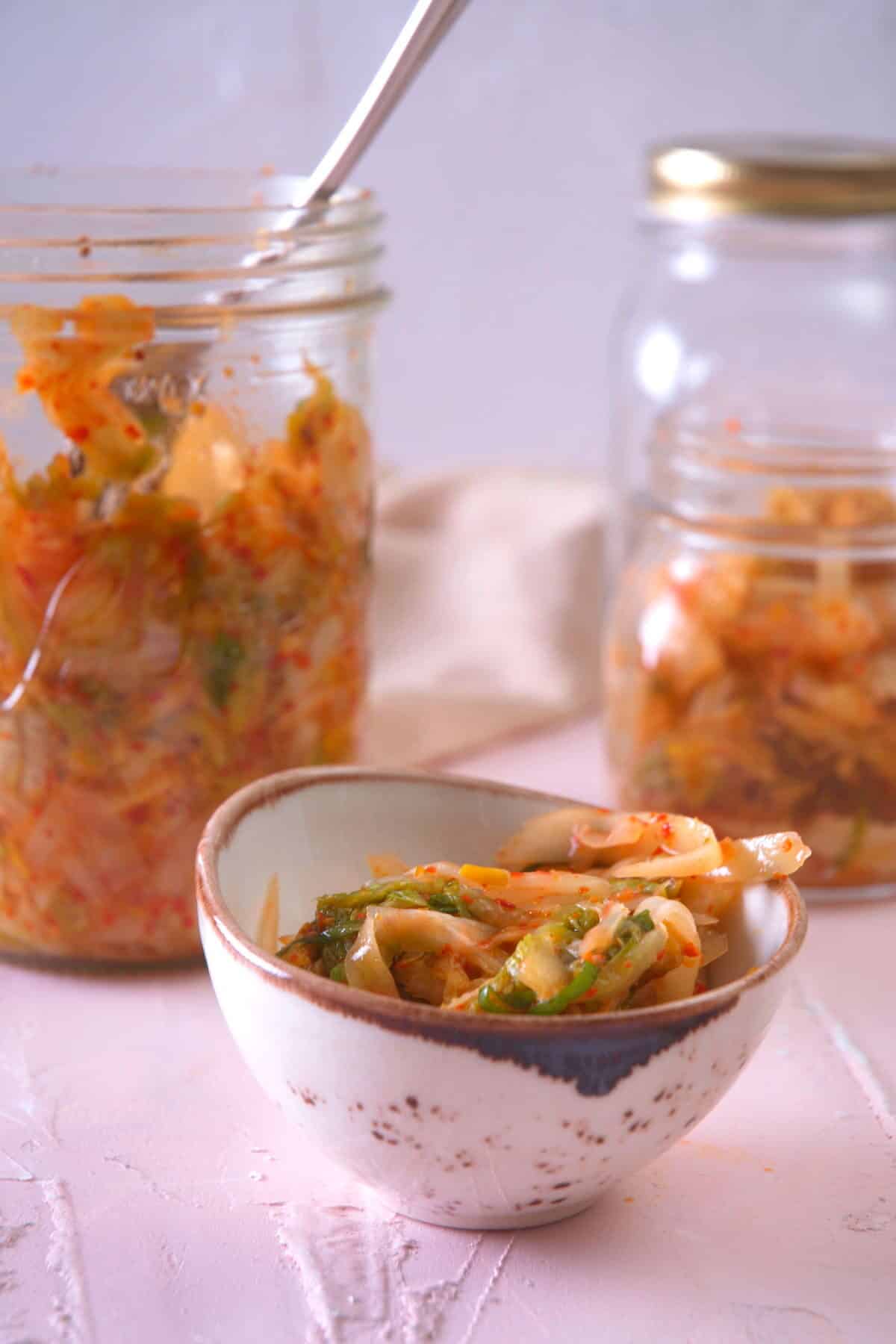
If you enjoyed this kimchi recipe tutorial, let me know in the comments and please share it!
📋Recipe
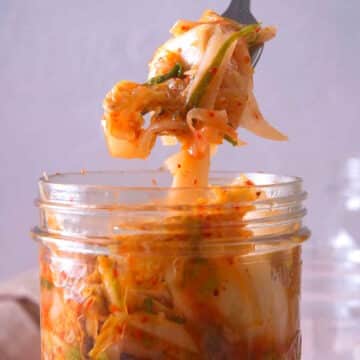
Kimchi
Ingredients
- 2 pounds napa cabbage - about 1 large head
- ¼ cup kosher salt
- distilled water - enough to cover the cabbage
- 5 cloves garlic - minced
- 1 tablespoon fresh ginger - minced
- 1 teaspoon sugar
- 2 tablespoons fish sauce
- 3 tablespoons gochugaru - Korean red pepper powder/course ground
- 2 tablespoons gochujang paste
- 1 cup daikon radish - peeled and grated
- 3 green onions - sliced
Instructions
- Remove any damaged outer leaves from the napa cabbage and then slice it into quarters. Core the cabbage and cut it into 2” pieces.2 pounds napa cabbage
- In a large bowl, add the cabbage pieces and salt (See Note 1).¼ cup kosher salt
- Massage the salt into the cabbage with your hands.
- Add enough of the distilled water to cover the cabbage. Stir until the salt has been dissolved.
- Cover the cabbage with an inverted plate and weigh it down with something heavy, like a jar/can. Let it sit for 2 hours at room temperature or up to 5 hours. This will draw out the moisture which will help preserve it and absorb the seasonings later.
- Drain the salt water from the cabbage and rinse it under cold water. Blot with paper towel to dry it and return it to the large bowl.
- To make the paste, stir the garlic, ginger, sugar, fish sauce, gochugaru and gochujang paste together until smooth.5 cloves garlic, 1 tablespoon fresh ginger, 1 teaspoon sugar, 2 tablespoons fish sauce, 3 tablespoons gochugaru, 2 tablespoons gochujang paste
- Combine the cabbage with the radish and green onions.1 cup daikon radish, 3 green onions
- Add the paste. Using your hands (you can use gloves), gently massage the paste into the cabbage mixture until all of the pieces are completely coated.
- Pack the kimchi into sanitized jars, pressing it down as you add it to minimize exposure to air. You want to leave about 2 inches of space at the top of the jar. To help keep the kimchi packed into the liquid, you can use some sort of weight placed on top of it (See Note 2). Wipe the jars down if needed and seal them with the lids (do not seal them tightly).
- Place the jars in a baking dish (to help catch any juices that may overflow) and set them in an area that is cool and dark. Let the kimchi sit for at least 24 hours or up to 5 days. If you see bubbling that means it is fermenting.Check the kimchi once per day to press down on the vegetables with a clean spoon and make sure they stay submerged under the brine. The cabbage will slowly release more brine over time (See Note 3). After 24 hours, you can start tasting the kimchi to see if it's fermented to your liking (it will be tangy). If not, you can leave it to ferment longer.
- The kimchi can now be stored in the refrigerator and is ready to eat (you can remove the weights and label the jar with the date). For full flavor, slowly ferment it further in the fridge for 1 to 2 weeks. You can eat it as is or add it to many different recipes!
Equipment
Notes
- Make sure you use kosher or sea salt so that it is free of additives/iodine, which is believed to negatively affect the fermentation process.
- It’s important that the cabbage stays covered in the brine for the lactic acid bacteria to multiply and to prevent mold. Fermentation weights come in handy for this or you can also use a cabbage leaf placed on top/tucked in with a weight on top of it.
- If you need more brine to keep the kimchi covered, you can mix 1 cup of water with 1 ¼ teaspoon kosher salt or sea salt. Use some of this mixture to top it up, if needed.
- This recipe yields about 5 pint jars of kimchi with 2" of headspace.
- The temperature range I ferment my kimchi in is between 65°F/18°C to 70°F/21°C and that works out great. The cooler you keep it, the longer it takes to ferment.
- To make it less spicy, add less gochugaru and/or gochujang.
- Store the kimchi in the fridge for up to 3 to 6 months.
Nutrition
Nutrition information on In the Kitch is provided as a courtesy and is an estimate only. It may not include toppings and/or sauces.

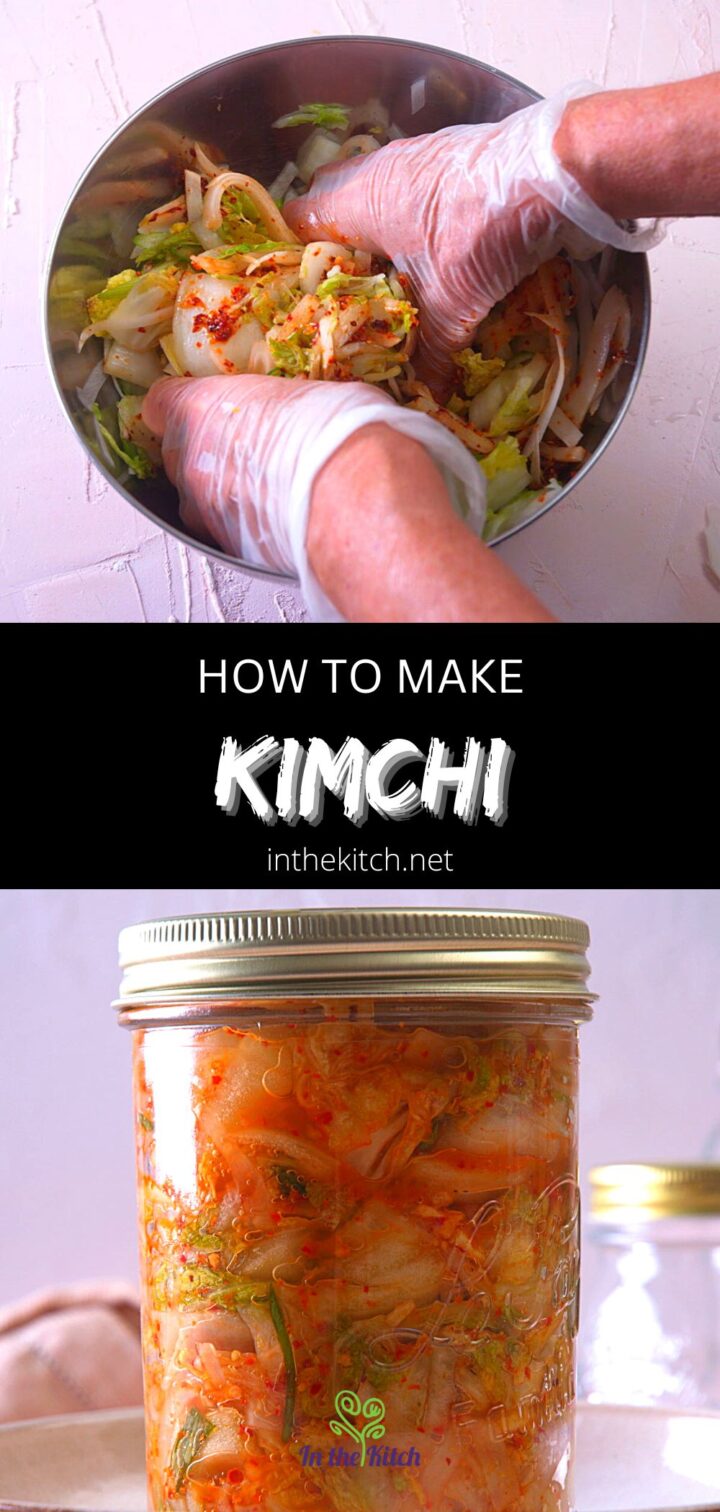
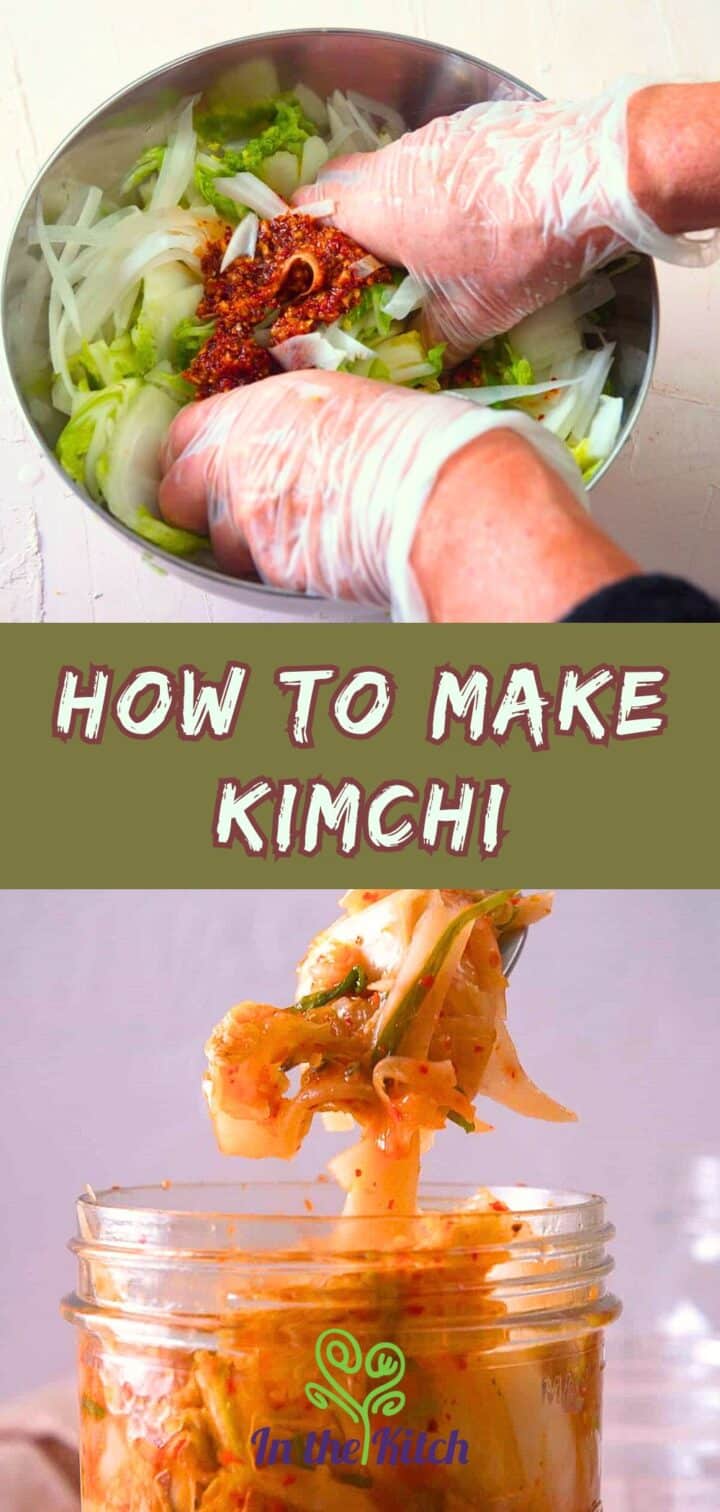
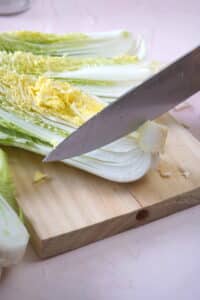
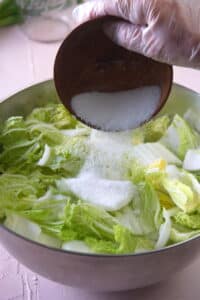

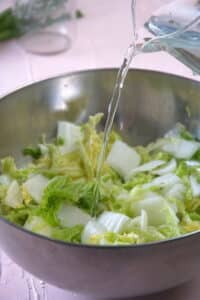
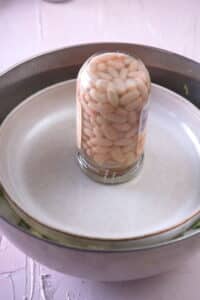
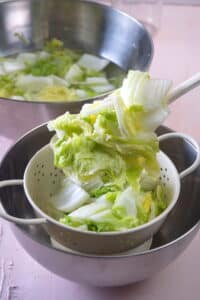
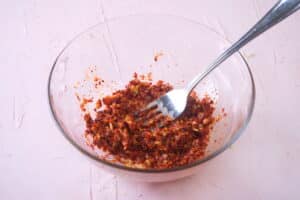
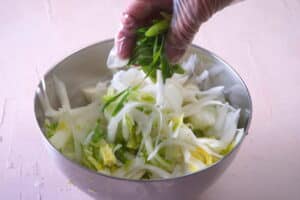
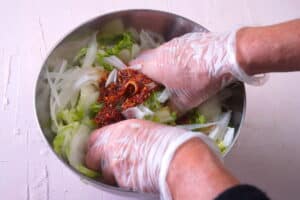
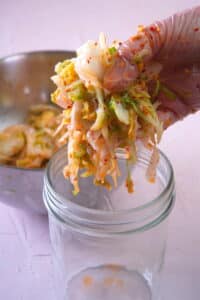
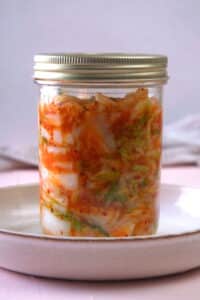
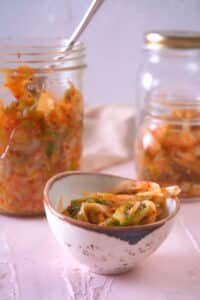
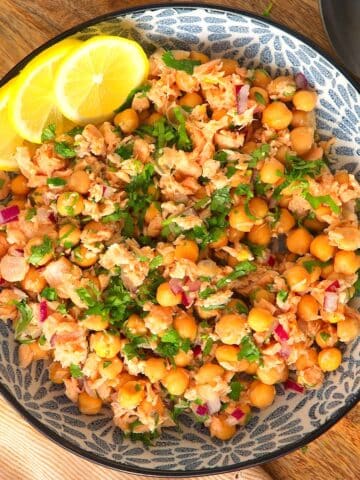
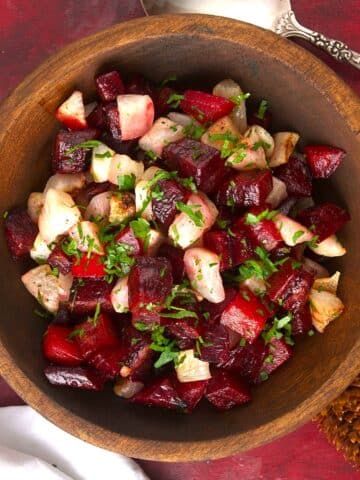
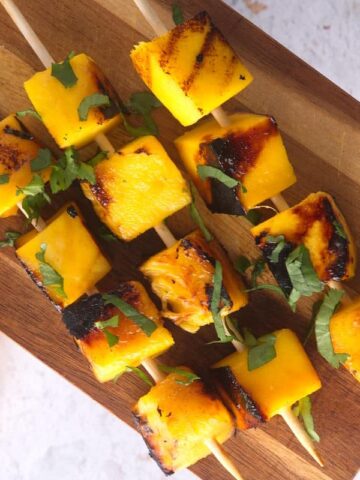
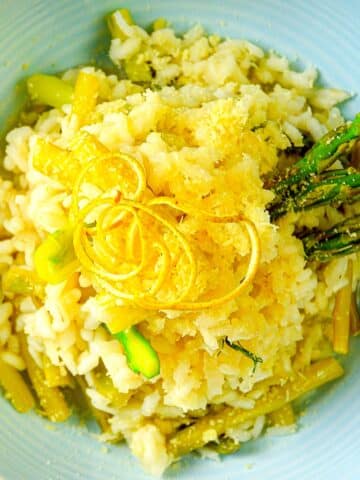
Leave a Reply